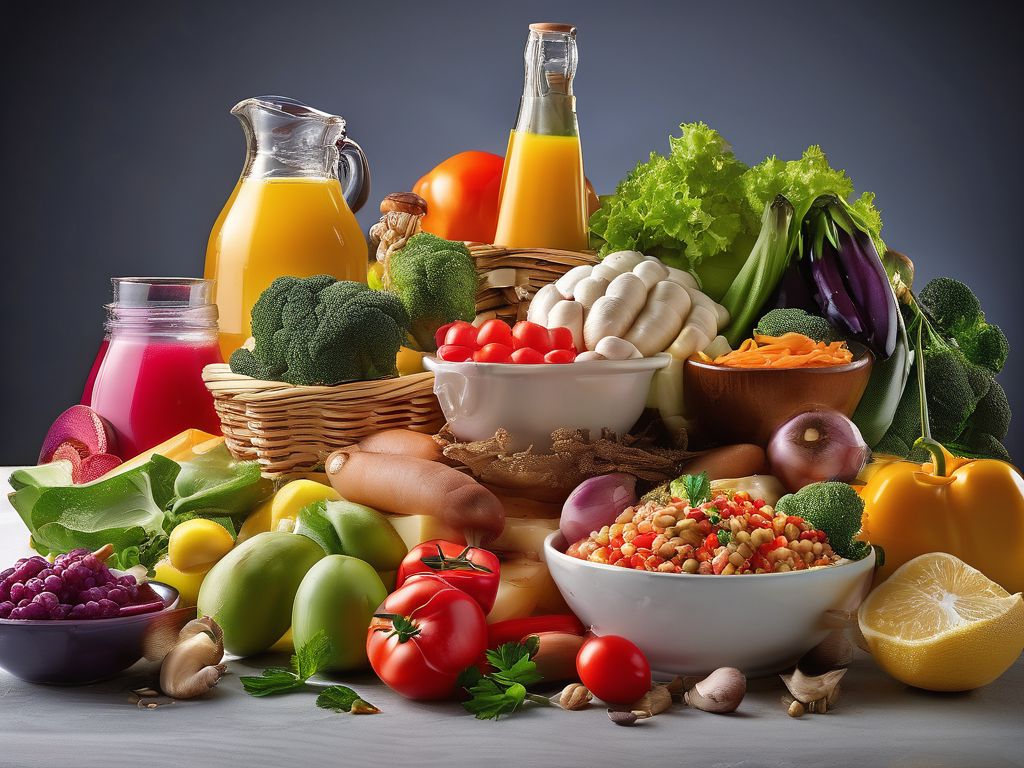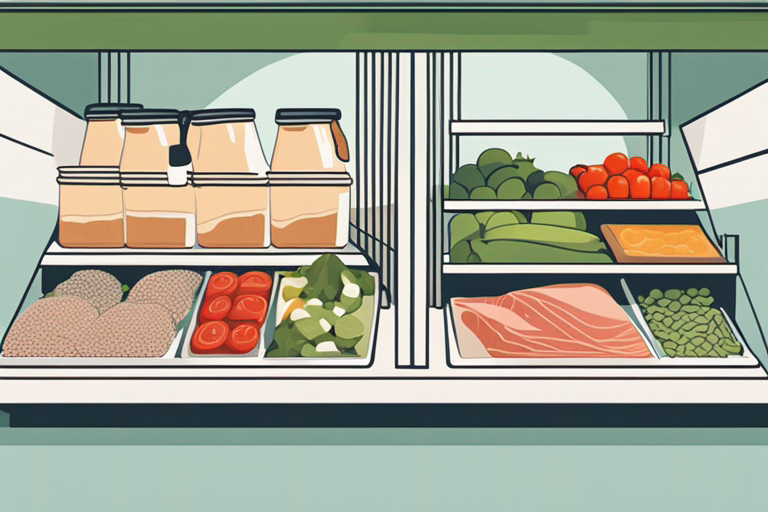
The Ultimate Guide to Foods That Don't Require Refrigeration
Get Your Free Food Safety Cheat Sheet
30 most common foods with instant answers. Print it and stick it on your fridge—completely free!
# The Ultimate Guide to Foods That Don't Require Refrigeration
In today's busy world, convenience is key when it comes to meal planning and food storage. While refrigeration is a common method to keep food fresh, there are many foods that do not require refrigeration and can be stored at room temperature. Knowing which foods can safely be stored outside of the fridge can help you save space, reduce energy consumption, and simplify your meal prep routine. In this comprehensive guide, we'll explore a variety of foods that don't require refrigeration, along with practical tips for proper storage and food safety.
## Benefits of Non-Refrigerated Foods
Non-refrigerated foods offer several benefits, including:
1. **Convenience**: Foods that don't require refrigeration are easy to store and grab on the go.
2. **Cost-Effective**: You can save money on electricity bills by reducing the need for refrigeration.
3. **Reduced Food Waste**: Some non-refrigerated foods have a longer shelf life compared to perishable items.
## Pantry Staples
### Grains and Legumes
- **Rice**: White rice, brown rice, and wild rice can be stored in a cool, dry place for up to a year.
- **Quinoa**: This versatile grain can be stored in an airtight container for several months.
- **Beans**: Dried beans such as black beans, chickpeas, and lentils can be stored in a pantry for up to a year.
### Canned Goods
- **Canned Vegetables**: Items like corn, peas, and tomatoes can be safely stored in a pantry.
- **Canned Beans**: Black beans, kidney beans, and garbanzo beans are convenient pantry staples.
### Nuts and Seeds
- **Almonds, Walnuts, and Pecans**: These nuts can be stored in a cool, dark place for several months.
- **Chia Seeds, Flaxseeds, and Sunflower Seeds**: These seeds have a long shelf life and can be stored in airtight containers.
## Fresh Produce
While many fruits and vegetables require refrigeration to extend their shelf life, some items can be stored at room temperature:
### Citrus Fruits
- Oranges, lemons, and limes can be stored in a fruit bowl or countertop.
### Root Vegetables
- Potatoes, sweet potatoes, onions, and garlic can be stored in a cool, dark place.
## Dairy and Dairy Alternatives
### Shelf-Stable Options
- **Powdered Milk**: Powdered milk can be stored in a pantry and used as needed.
- **Shelf-Stable Almond Milk**: Some brands offer almond milk that does not require refrigeration until opened.
## Baked Goods and Snacks
### Bread and Crackers
- **Bread**: Store bread in a breadbox or a cool, dry place to maintain freshness.
- **Crackers**: Crackers can be stored in a pantry or airtight container for several weeks.
### Dried Fruits
- Raisins, apricots, and figs can be stored in a pantry for months.
## Real-Life Scenarios
Imagine you're heading off for a weekend camping trip. You want to bring snacks that are easy to transport and won't spoil in the heat. Packing items like trail mix (made from non-refrigerated nuts and dried fruits) and whole grain crackers can keep hunger at bay without the worry of spoilage.
Or consider a busy parent who needs quick meal options for their family. Stocking a pantry with canned beans and shelf-stable veggies means that they can whip up a nutritious meal in minutes—a lifesaver on those hectic weeknights!
Another scenario could be when you're moving into a new apartment. While it can take days (or longer) to get utilities set up, having a selection of shelf-stable foods means you won’t have to rely on takeout. With some rice, canned tomatoes, and spices, you can create a comforting meal without needing to refrigerate anything.
## Scientific Context: The Science of Preservation
Many of the non-refrigerated foods we consume have been preserved using various methods that inhibit bacterial growth and spoilage. For example, **canning** involves sealing food in airtight containers and then heating them to kill bacteria and enzymes. This process allows canned goods to be shelf-stable for years.
Similarly, **dehydration** is a technique used on fruits and vegetables to remove moisture, which is a key factor in spoilage. By reducing the water content, it prevents the growth of mold and bacteria. Products like dried fruits and jerky are excellent examples of this preservation method.
Understanding these processes can enhance your appreciation for the foods in your pantry. It's also a good reminder that not all shelf-stable foods are created equal—in terms of nutrition or safety—so always be diligent in checking for quality.
## Practical Tips for Pantry Organization
To make the most out of your non-refrigerated foods, organization is key. Here are some practical tips to keep your pantry efficient and effective:
- **Labeling**: Use clear labels with expiration dates on containers. This will help you keep track of what needs to be used up first.
- **Use Airtight Containers**: Invest in a set of airtight containers for items like grains, nuts, and seeds. This not only keeps them fresh but also protects them from pests.
- **Store in a Cool, Dark Place**: Ensure that your pantry is cool and dark. Light and warmth can degrade food over time, especially oils and nuts.
- **Organize by Category**: Group similar items together (canned goods, grains, snacks) so you can quickly find what you need without digging through everything.
## Common Mistakes to Avoid
Many people don’t realize that not all foods can be stored indefinitely, even if they are non-perishable. Here are some common pitfalls to avoid:
- **Ignoring Expiration Dates**: Just because a food doesn’t require refrigeration doesn’t mean it lasts forever. Always pay attention to expiration or best-by dates.
- **Storing in Improper Conditions**: Avoid storing non-refrigerated foods in humid areas like near stoves or sinks. Humidity can cause spoilage or mold growth.
- **Overlooking Storage Techniques**: Just tossing items into the pantry can lead to waste. Use proper storage methods for each type of food to maximize their shelf life.
## Expert Insights: Food Safety Recommendations
As a food safety expert, I always emphasize the importance of being mindful about food storage. Here are some expert recommendations:
- **Check for Signs of Spoilage**: Even shelf-stable foods can spoil. Always check for off smells, unusual colors, or textures before consuming.
- **Rotate Stock**: Practice FIFO—First In, First Out. Always use older items first to reduce the chances of wasting food.
- **Educate Yourself on Food Labels**: Familiarize yourself with terms like "sell by," "use by," and "best before" to make informed decisions about food consumption.
- **Keep a Food Safety Checklist**: Create a simple checklist to quickly assess your pantry items and their status. This can save you from unpleasant surprises.
## Safety Warnings: Important Cautions
When it comes to non-refrigerated foods, it's vital to be proactive about safety:
- **Avoid Cross-Contamination**: Always wash your hands and surfaces before handling food items. This is crucial, especially when switching between raw and cooked items.
- **Be Wary of High-Risk Foods**: Some foods, like home-canned goods or those made with oils, can be risky if not prepared correctly. Always follow safe canning guidelines.
- **Temperature Checks**: If you ever suspect that a non-refrigerated item may have been exposed to extreme temperatures, err on the side of caution and discard it.
## Conclusion
Incorporating non-refrigerated foods into your meal planning can help streamline your kitchen routine and ensure you always have convenient options on hand. By following proper storage guidelines and food safety tips, you can enjoy a variety of pantry staples, fresh produce, and shelf-stable items without the need for refrigeration. Experiment with different non-perishable foods to discover new flavors and meal ideas while simplifying your food storage strategy.
Embracing non-refrigerated foods doesn't just simplify your meal prep; it can also enrich your culinary experiences. Whether you’re camping, moving, or just trying to create a well-stocked pantry for easy weeknight dinners, understanding how to effectively utilize these foods can lead to delicious possibilities.

Authoritative Food Safety References
These agencies and university labs inform every tip and health precaution we publish.
USDA FoodKeeper – Cold Storage Guidelines
Official refrigerator, freezer, and pantry timelines maintained by the U.S. Department of Agriculture.
Visit USDA FoodKeeperFDA Produce Safety Rule & Grower Guidance
Field-to-fridge handling practices that prevent contamination of fruits, vegetables, and leafy greens.
Visit FDA Produce SafetyCDC Foodborne Illness Prevention Hub
Surveillance-backed guidance on pathogens, symptoms, and steps to reduce foodborne illness risk.
Visit CDC Food SafetyUC Davis Postharvest Technology Center
University research detailing optimal storage atmospheres for produce after harvest.
Visit UC Davis PostharvestPenn State Extension – Home Food Preservation & Safety
Peer-reviewed extension bulletins on safe canning, chilling, and reheating practices.
Visit Penn State ExtensionCan I store eggs outside of the refrigerator?
How long can canned foods last without refrigeration?
Is it safe to consume unrefrigerated cheese?
Can fruits and vegetables be stored outside of the refrigerator?
How should I store bread without refrigeration?
Get Your Free Food Safety Cheat Sheet
30 most common foods with instant answers. Print it and stick it on your fridge—completely free! Want more? Upgrade to the complete guide with 70+ foods.
Scan your food directly and get instant safety info using our AI-powered camera feature.